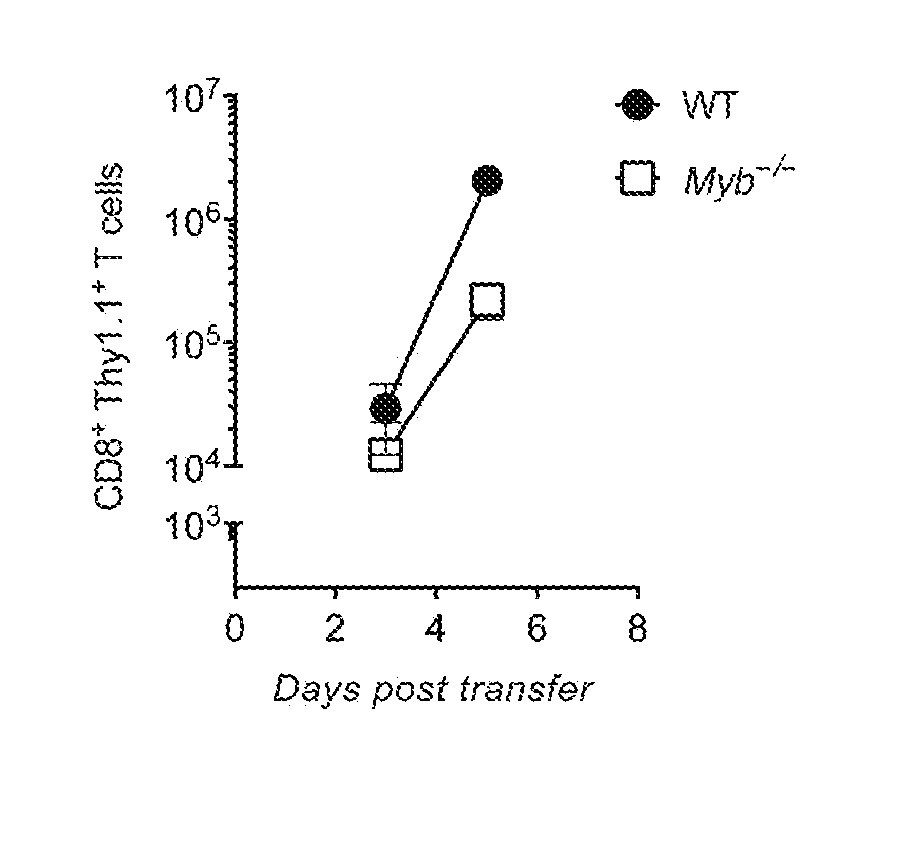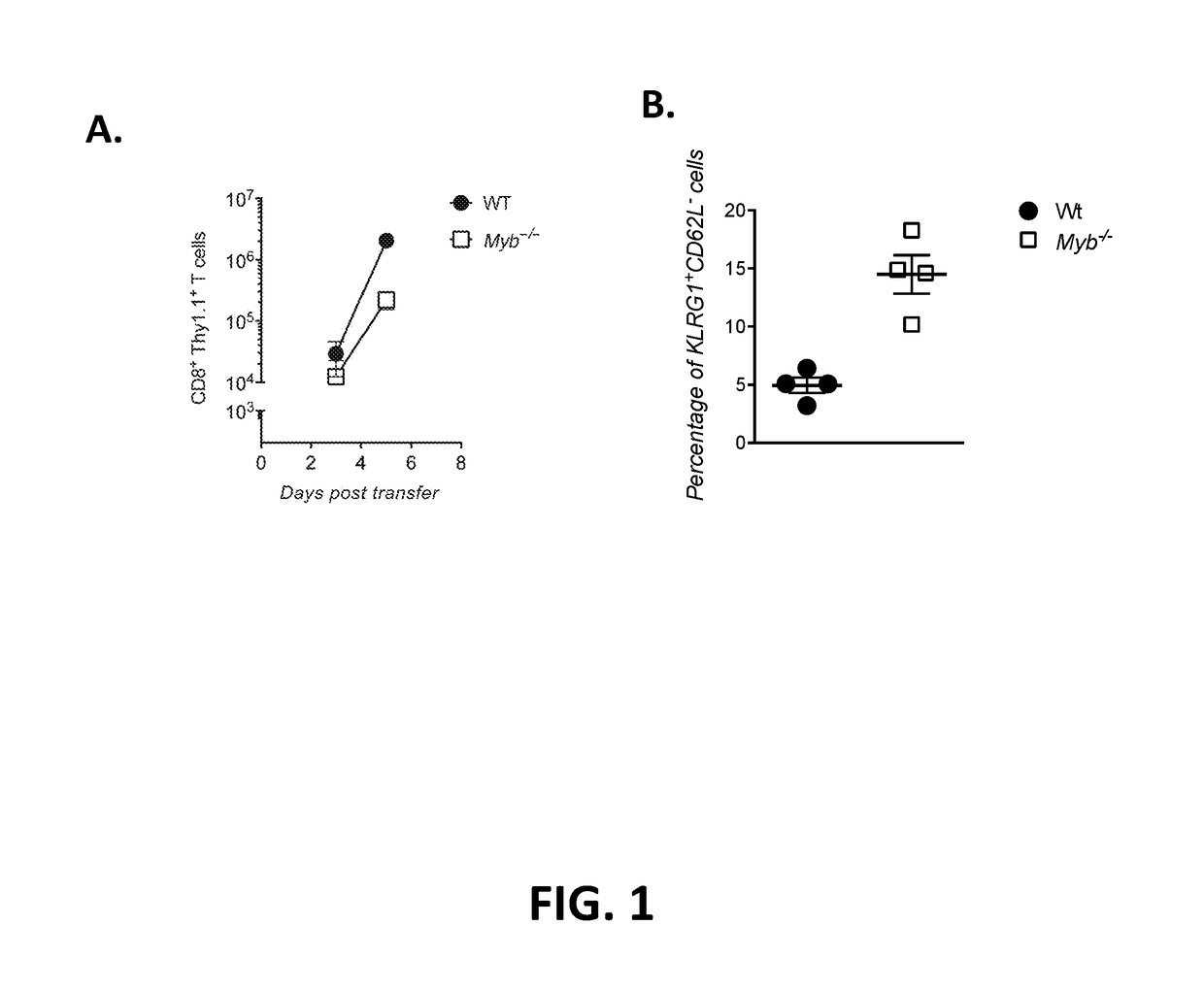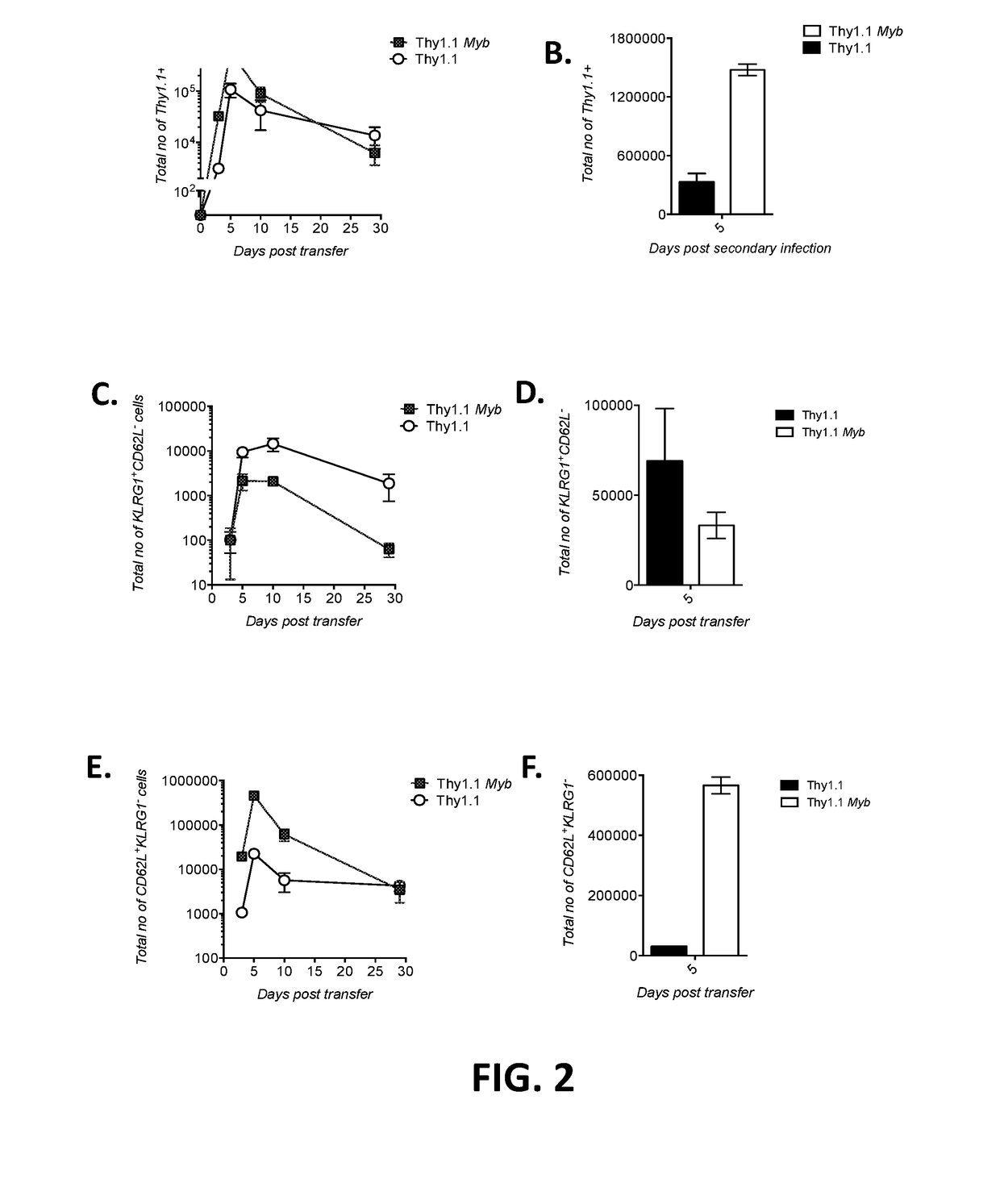T cells modified to overexpress c-myb
a technology of t cells and myb, which is applied in the field of t cells modified to overexpress c-myb, can solve the problems of increasing the differentiation of t cells and posing obstacles to the treatment of diseases, and still exist obstacles to the overall success of adoptive cell therapy
- Summary
- Abstract
- Description
- Claims
- Application Information
AI Technical Summary
Benefits of technology
Problems solved by technology
Method used
Image
Examples
example 1
[0107]This example demonstrates that deficiency of c-Myb impairs accumulation of the numbers of T cells.
[0108]The pme1-1 mouse model is a useful tool for modeling the treatment of malignant melanoma using adoptive cell therapy (Overwijk et al., J. Exp. Med., 198(4): 569-80 (2003)). Adoptive transfer of T cells expressing the anti-gp100 TCR from pme1-1 mice can effectively mediate the regression of tumors when administered in combination with a lymphodepleting pretreatment regimen, cytokine administration, and vaccination (Zeng et al., J. Exp. Med, 201: 139-148 (2005); Gattinoni et al., J. Exp. Med., 202: 907-912 (2005); Klebanoff et al., Proc. Natl. Acad. Sci. USA, 101:1969-1974 (2004)).
[0109]CD8+ T cells were isolated from pme1-1 wild-type (WT) mice and Myb knockout mice (Myb− / −). The isolated T cells were transduced with a retroviral vector encoding the Thy1.1 antigen in order to facilitate assessment of the T cells by flow cytometry upon transfer into host mice. The transduced CD...
example 2
[0111]This example demonstrates that deficiency of c-Myb promotes differentiation.
[0112]Pme1-1 WT CD8+ T cells or pme1-1 Myb− / − CD8+ T cells were transduced and adoptively transferred into infected WT mice as described in Example 1. The expression of KLRG1 and CD62L by Thy1.1+ pme1-1 CD8+ T cells that were isolated from spleen was measured by flow cytometry on day 5 after adoptive transfer.
[0113]The percentages of cells expressing the indicated phenotypes are shown in Table 2. The percentage of KLRG1+CD26L− cells obtained from four mice is shown in FIG. 1B.
TABLE 2WTMyb− / −KLRG1+ / CD62L+4.648.94KLRG1− / CD62L+4834.1KLRG1+ / CD62L−5.0918.3KLRG1− / CD62L−42.338.7
[0114]As shown in Table 2 and FIG. 1B, deficiency of c-Myb promotes T cell differentiation.
example 3
[0115]This example demonstrates that overexpression of c-Myb enhances T cell proliferation.
[0116]CD8+ T cells were isolated from pme1-1 WT mice. The isolated T cells were transduced with a retroviral vector encoding (i) Thy1.1 only (“Thy1.1”) or (ii) Thy1.1 and c-Myb (SEQ ID NO: 4) (“Thy1.1 Myb”).
[0117]Thy1.1 CD8+ T cells (5×104) or Thy1.1 Myb CD8+ T cells (5×104) were adoptively co-transferred into WT mice infected with gp100-VV. The expression of Thy1.1 and Ly5.1 by splenic T cells was measured by flow cytometry (after gating on CD8+ T cells) 3-30 days after infection and 5 days after heterologous infection with gp100 adenovirus (on day 30 of gp100-VV infection). The percentages of Thy1.1+ Ly5.1− or Thy1.1+ Ly5.1+ cells are shown in Table 3 and the abundance of Thy1.1+ T cells 0-30 days (FIG. 2A) and 5 days (FIG. 2B) after heterologous infection with gp100 adenovirus is shown in FIGS. 2A-2B.
TABLE 3Thy1.1+ Ly5.1−Thy1.1+ Ly5.1+Day 049.549.3Day 3 after infection0.01850.179Day 5 after...
PUM
| Property | Measurement | Unit |
|---|---|---|
| Fraction | aaaaa | aaaaa |
| Magnetic field | aaaaa | aaaaa |
| Time | aaaaa | aaaaa |
Abstract
Description
Claims
Application Information
 Login to View More
Login to View More - R&D
- Intellectual Property
- Life Sciences
- Materials
- Tech Scout
- Unparalleled Data Quality
- Higher Quality Content
- 60% Fewer Hallucinations
Browse by: Latest US Patents, China's latest patents, Technical Efficacy Thesaurus, Application Domain, Technology Topic, Popular Technical Reports.
© 2025 PatSnap. All rights reserved.Legal|Privacy policy|Modern Slavery Act Transparency Statement|Sitemap|About US| Contact US: help@patsnap.com



